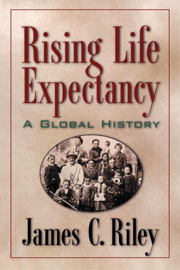Book contents
- Frontmatter
- Dedication
- Contents
- List of Figures, Maps, and Tables
- Preface and Acknowledgments
- Introduction: A Global Revolution in Life Expectancy
- 1 A Brief Overview of the Health Transition
- 2 Public Health
- 3 Medicine
- 4 Wealth, Income, and Economic Development
- 5 Famine, Malnutrition, and Diet
- 6 Households and Individuals
- 7 Literacy and Education
- Conclusion
- Index
5 - Famine, Malnutrition, and Diet
Published online by Cambridge University Press: 05 February 2015
- Frontmatter
- Dedication
- Contents
- List of Figures, Maps, and Tables
- Preface and Acknowledgments
- Introduction: A Global Revolution in Life Expectancy
- 1 A Brief Overview of the Health Transition
- 2 Public Health
- 3 Medicine
- 4 Wealth, Income, and Economic Development
- 5 Famine, Malnutrition, and Diet
- 6 Households and Individuals
- 7 Literacy and Education
- Conclusion
- Index
Summary
Undernutrition and overnutrition both elevate mortality. For most of the history of the health transition, undernutrition posed the more serious threat. Food supplies failed, causing famine; some people ate too little so often that they were chronically undernourished; many people consumed diets deficient in particular nutrients. Many of the economic and geographic trends of the last 200 years have also favored overnutrition, with resulting obesity and degenerative diseases. At the end of the twentieth century the two problems coexist. Poorer people, especially in developing countries, are likelier to face malnutrition than other populations. But many people in poorer countries are also showing signs of obesity.
The relationship between nutrition and good health is not yet fully understood. On one hand, a deficiency of specific nutritional elements may damage the immune system (zinc deficiency) or expose a person to a particular disease (iodine deficiency). Deprivation in the prenatal period or in infancy adds to adult vulnerability to chronic disease. A deficit of calories during growth grave enough to result in stunting may place an individual at serious risk to sickness and death. Population–level malnutrition, especially protracted malnutrition, may provoke actions that make it easier for communicable diseases to spread. On the other hand, pathogens generally require the same nutrients as do human hosts, so that they often find it difficult to live and reproduce in poorly nourished hosts. Experiments with animal models suggest that undernutrition can extend survival and elongate reproductive years.
- Type
- Chapter
- Information
- Rising Life ExpectancyA Global History, pp. 145 - 168Publisher: Cambridge University PressPrint publication year: 2001



